monday reviews is our latest blog series where we provide the facts about different project management tools—no BS and no hyperbole needed. Keep scrolling for our analysis and to learn more about all the project management tools out there. Enjoy! 😊
We understand that no matter how hard we try, we can’t be right for everyone.
While we’re always working to improve and to develop new features based on customer feedback, we understand that sometimes, we won’t be your project management soulmate.
But, we still want to be helpful nonetheless.
In this article, we’ll walk you through our favorite monday.com alternative, it’s key features, strengths and weaknesses, and compare our two tools side by side.
Salesforce is monday.com’s favorite pick for businesses who need an alternative CRM
Customer resource management (CRM) is incredibly unique to every business. Your customer experience is a direct result of how they’re managed by your team — a process in which your CRM tool is critical.
Your CRM also encompasses every part of your business — marketing, finance, product, operations, human resources, sales, account management and customer service all play a key role in your customer journey, and it all comes together in your CRM.
The monday.com work operating system (OS) does have the tools you need to build a robust CRM, but if it turns out it’s just not right for you, Salesforce is our top alternative.
Salesforce has been the market leader for CRM tools for 20 years. Over 150,000 enterprise sales teams have used Sales Cloud, their core offering, to close deals fast and scale their businesses. Salesforce 360 is their CRM tool that connects businesses with customers by uniting sales, service, marketing, commerce, IT, and analytics all in one place.
With Salesforces, businesses have a complete view of their customer experience and journey. This includes:
- An activity history of how and when they’ve made contact with you
- Contact information
- A history of communications you’ve initiated with them
- Internal account discussions
- Dashboards
- And more
You can also pull in insightful data from social media tools like Facebook Twitter and LinkedIn.
It’s all collected in a clean dashboard that visually displays information about where each customer is in their journey.
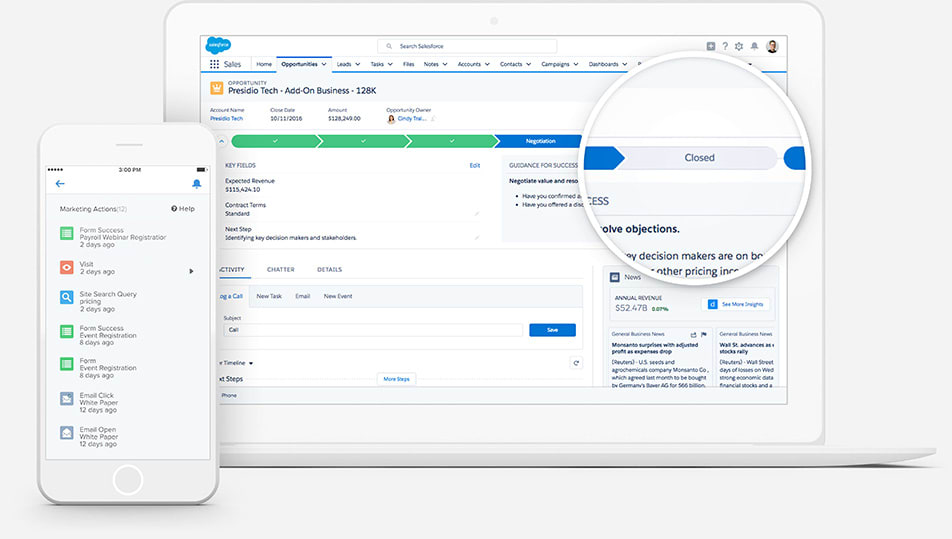
The Salesforce dashboard allows for the same treatment of leads and opportunities as customers. Their opportunity management feature collects and displays information like:
- Stage in the funnel
- Products interested in or previously purchased
- Competition
- Quotes
- Target close date
- Company information
- Detailed notes
- And more
Sales professionals can keep track of opportunities from the first time they visit your website to the time they close the deal. Integrations with other tools in the marketing, customer service, finance and technology departments allow them to optimize communications along the way.
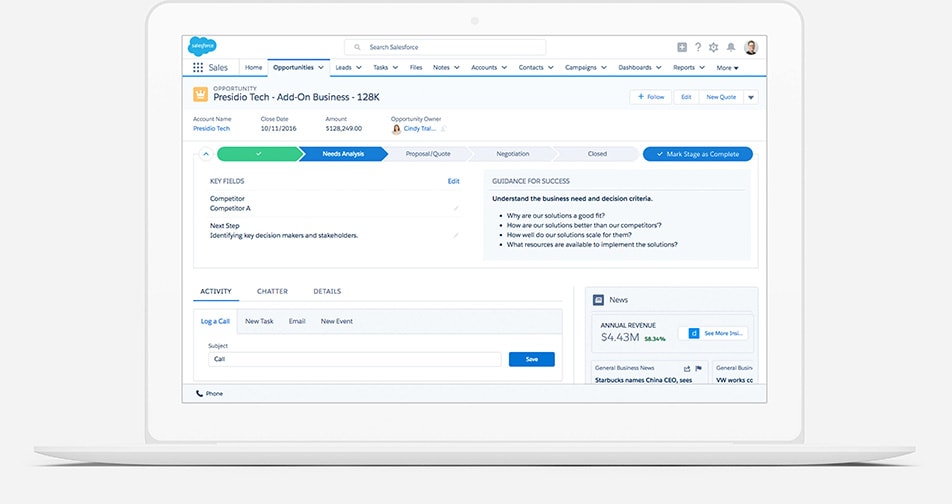
Salesforce dashboards allow you to have a real-time picture of your pipeline, and act as a window to more detailed dashboards if you need to drill down on the data.
This example dashboard allows teams to easily see revenue by quarter, average deal closed, revenue for the current month, and the number of completed activities. Data is then broken down by segment, account and shown as trends over time.
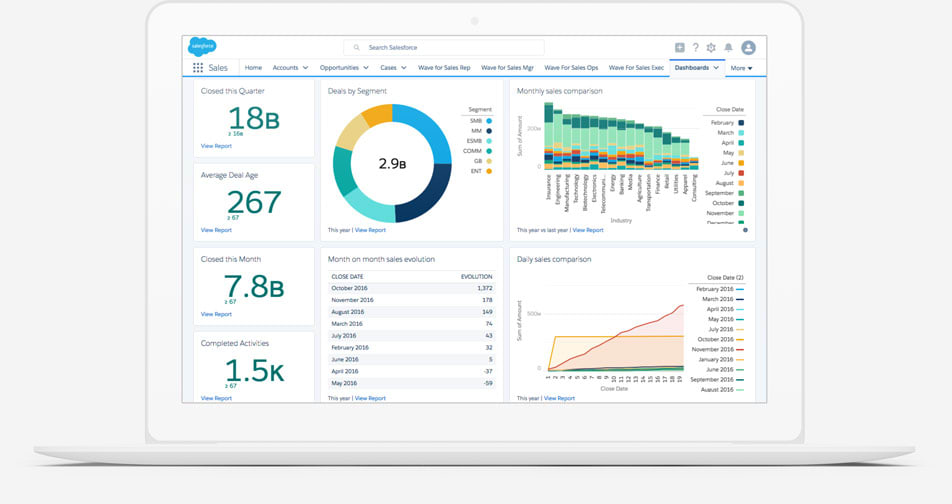
monday.com vs. Salesforce
We’d be remiss if we didn’t mention that businesses can build a CRM just as holistic as Salesforce using monday.com’s work OS. Plus, they don’t have to start from scratch — we have a template to get you started.
Opportunities and customers are organized similarly in monday.com, with assigned owners and status updates that when changed, automatically send communications to customers.
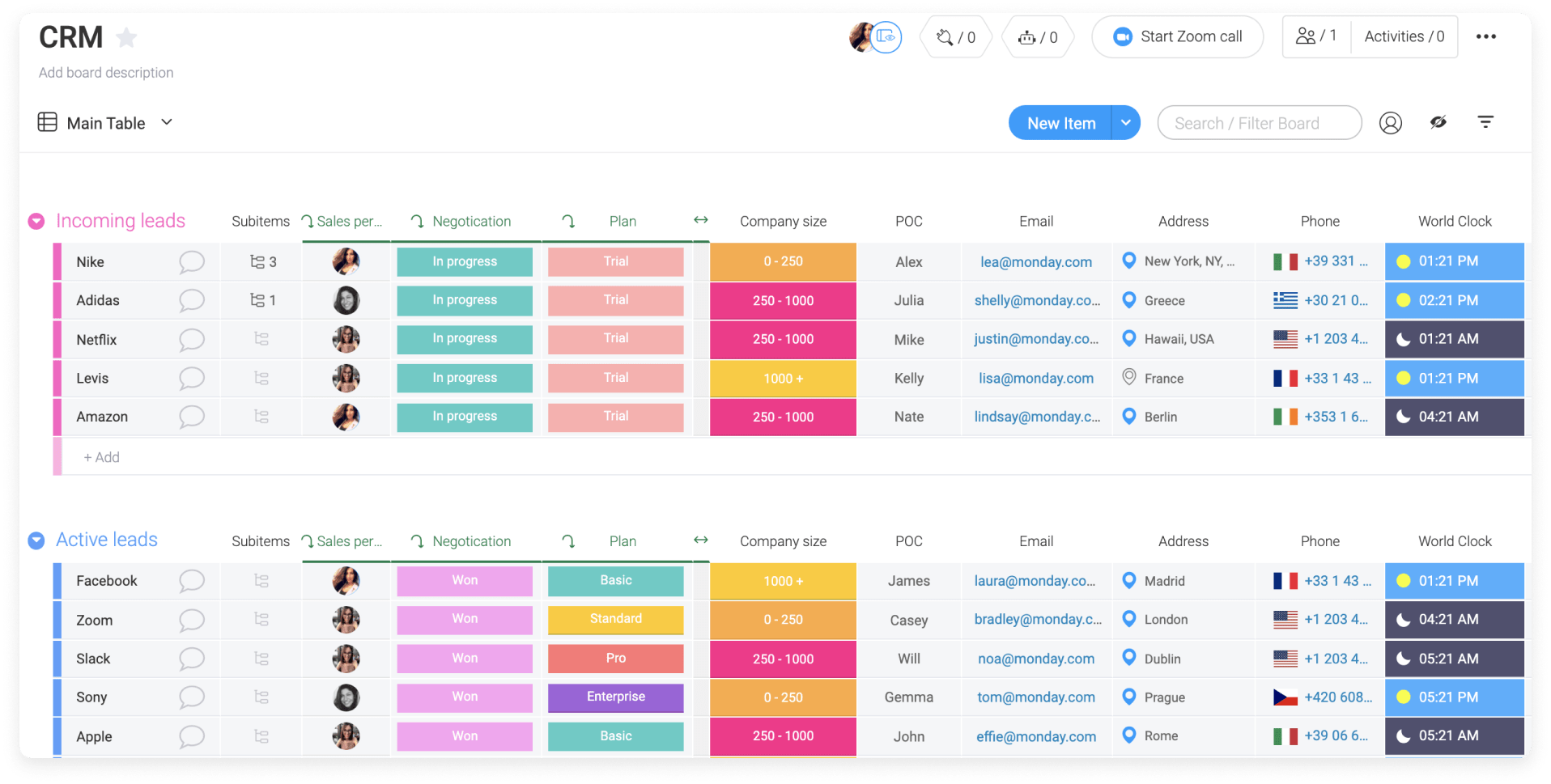
Teams can also collect information like their point of contact’s email, address, phone number, time zone and so much more. Columns can be customized to fit every unique business need.
Much like in Salesforce, data is aggregated in a dashboard that provides an easy-to-understand overview of your pipeline at any given time.
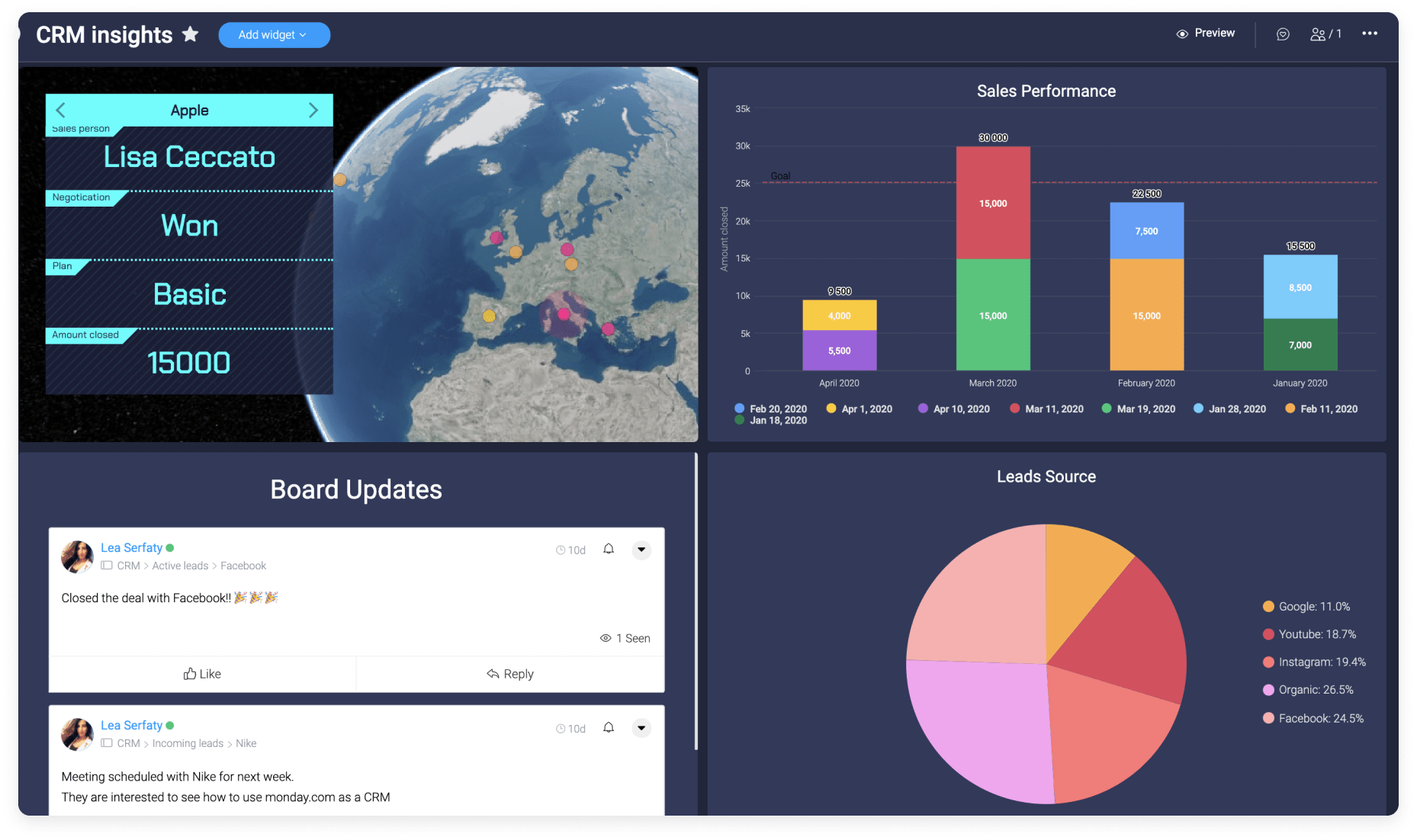
One of the most powerful monday.com features is automation. You can automate things like status updates and notifications between team members, but you can also integrate our tool with email, marketing technology and social media tools to send automated messages to customers seamlessly.

They automated their follow up processes so that when an opportunity’s status changed in monday.com, they automatically were sent a relevant whitepaper via email or LinkedIn messaging.
They also planned for changes on their feet — communications could be stopped at any time, and were automatically paused if an opportunity progressed in a way that made the planned communication irrelevant.
They can now achieve so much more as a small team. They send almost 2,000 emails and up to 150 LinkedIn connection requests a day on average — all of which are high-quality communications.
Check out this video for a full breakdown of how they built a functioning CRM using monday.com’s work OS:
When you take a look at both Salesforce and monday.com at a high level, there are really only a few details that differ:
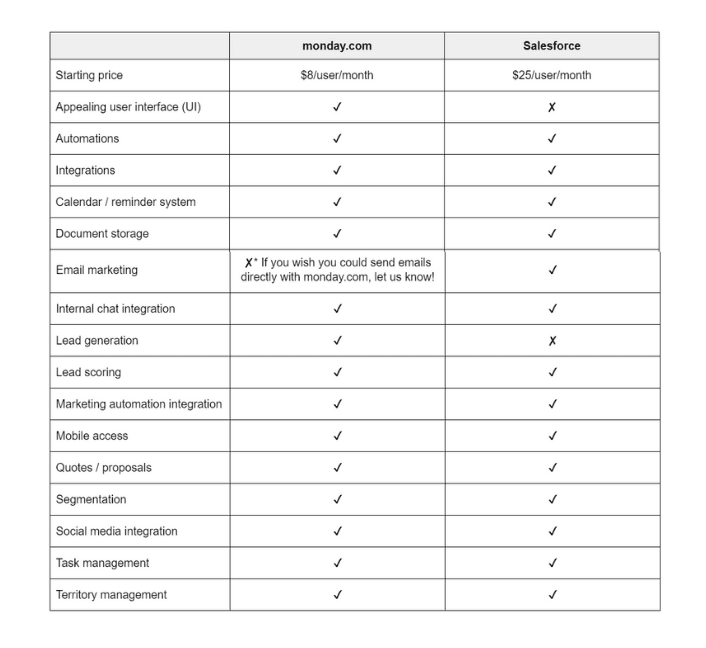
As you can see, both platforms serve most business’s CRM needs, and where there are gaps, there are integrations with common tools to easily fill them.
Speaking of integrations, if you do work with Salesforce, you can still work with monday.com on other projects and stay in sync across teams.
monday.com’s integration with Salesforce makes it easy to stay connected across your organization
If you’re still convinced that Salesforce is the right choice for you, we understand. We also want you to know that if you’re using monday.com for other project management needs, you can integrate your Salesforce instance directly with monday.com for seamless alignment between teams.
Our integration makes it so that every time an opportunity or customer is created or updated in Salesforce, like so…

…that opportunity or customer is also updated in monday.com, and vice versa.

Here’s a breakdown of exactly which fields can be shared across tools:
- Standard Salesforce fields: campaign, account, case, lead, opportunity, and contact
- Custom Salesforce fields: custom fields, id, boolean, string, picklist, multipicklist, textarea, double, address, phone, email, URL, currency, int, date, and datetime.
- monday.com fields: custom fields, boolean, string, picklist, multipicklist, textarea, double, address, phone, email, URL, currency, int, date, datetime, and percent.
For a full breakdown of how to implement this integration in your monday.com instance, check out this video:
Why monday.com offers the best platform for growth in 2021
We truly believe that the monday.com Work OS is built on a foundation of features, apps, and tools that make us the best platform for your team’s work.
For one, our user interface is beautiful and easy to use (without any crazy learning curve, which Salesforce is sometimes accused of).
Our drag and drop interface is unique in comparison with Salesforce, and makes updates and changes to your workflow easy to execute.
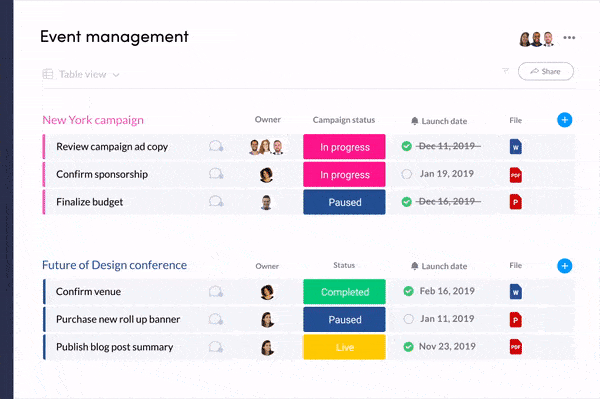
We offer tons of templates for teams to reduce any potential learning curve as much as possible, and also to provide a starting point for our customers who don’t always have the time to build dashboards from scratch.
We already mentioned our CRM template, but we have so many others that work to unite your customer experience at all stages of their journey, including sales processes, recruitment, supply orders, product roadmap, marketing and so much more.
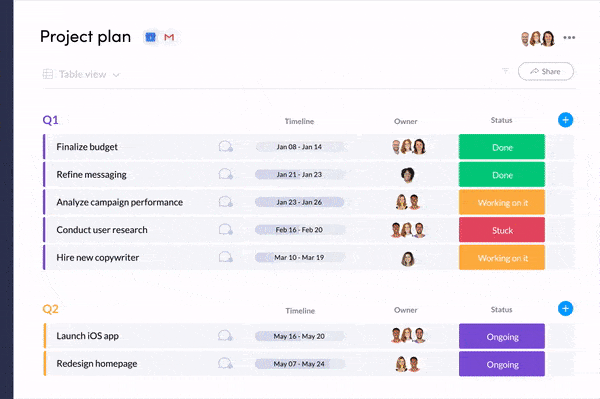
We automate the part of your workflow that makes sense — like status updates and notifications — so that nothing ever falls through the cracks.
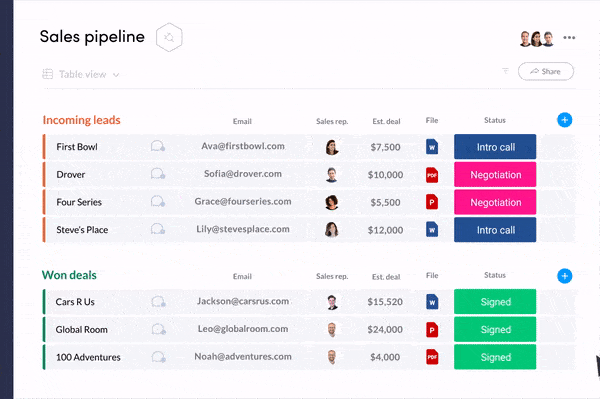
We integrate with most major organizational tools so that you can view all projects at a high-level with monday.com, without any missing data.
We mentioned our integration with Salesforce, but our suite of partners includes major players in every space, including customer service, development, office products, finance tools, recruitment tools, and more.
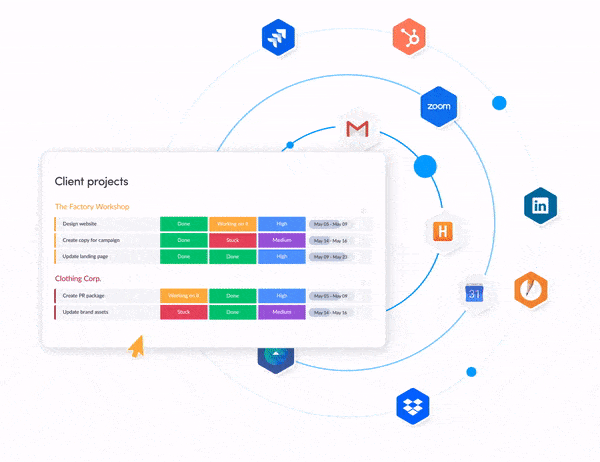
Last but not least, we won’t make your organization stick to one view. Whether it’s a Kanban board, Gantt chart, timeline, table, or another project view that works best for your team, you can toggle between them all.
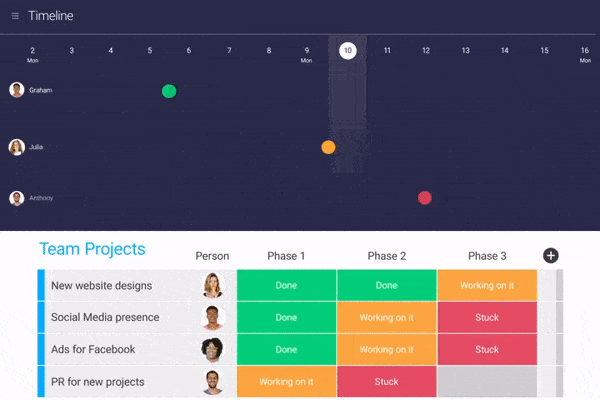
The choice is yours
If you still feel like monday.com isn’t the right choice for you, Salesforce is a good place to start.
We’re always looking to improve our software, add new features that our customers want, and incorporate customer feedback with improvements and feature updates.
We genuinely believe that we can support your team in whatever business project is on your plate.
If you’re interested in giving us a shot, contact us right away.


